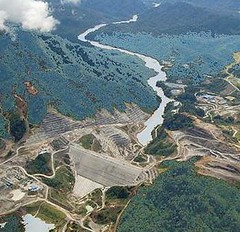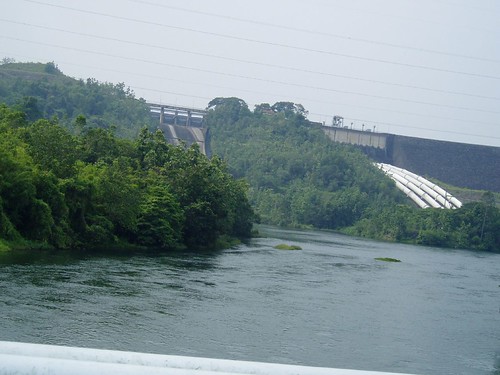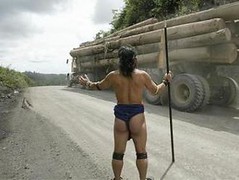 馬來西亞政府在婆羅洲島沙勞越州規劃開發12座大型水壩,全數面臨社區居民反對,並要求針對水壩開發進行公民投票。
馬來西亞政府在婆羅洲島沙勞越州規劃開發12座大型水壩,全數面臨社區居民反對,並要求針對水壩開發進行公民投票。
150位原住民及民間團體代表18日於美里(沙勞越第二大城)舉行會議,會中要求州政府解決沙勞越現有水力電廠的不利影響,並且停止在雨林興建更多電廠以支應工業發展。
與會者達成共識,認為政府應當尊重人民的反對水壩興建計畫的權利,特別是那些首當其衝的人民。他們呼籲政府應促進發展微型水力電廠、太陽能、風能與生質能源來替代大型水壩。
全體與會者一致認為政府最起碼應該要在舉辦公聽會諮詢受影響的人民後,進行全民公投。
原住民團體要求立即解決已經興建或是正在興建中水壩對人民的影響,尤其是具重要性且懸而未決的問題。
大會並發表了一項聲明,譴責沙勞越政府在巴當艾(Batang Ai)、班谷(Bengoh)與巴貢水壩後,還計畫興建另外12個水壩。
 沙勞越巴當艾國家公園內110米高的水壩是由亞洲開發銀行所資助,1985年起營運。這個水壩使26間長屋中約3000人被迫遷移。《沙勞越森林史》(A History of Forestry in Sarawak)作者 Amarhit Kaur 表示,這些人獲重新安置去種植可可與橡膠,但是計畫最後失敗了。
沙勞越巴當艾國家公園內110米高的水壩是由亞洲開發銀行所資助,1985年起營運。這個水壩使26間長屋中約3000人被迫遷移。《沙勞越森林史》(A History of Forestry in Sarawak)作者 Amarhit Kaur 表示,這些人獲重新安置去種植可可與橡膠,但是計畫最後失敗了。
位在沙勞越基里(Kiri)河的班谷大壩,預計在2012年底完工。來自四個村莊約250個家庭的1500位居民拒絕了政府的安置計畫──在靠近水壩處提供每戶家庭一間免費住宅與3英畝土地。這些人希望能在水壩上游處定居,那裡是他們的傳統領域。
63公尺高的班谷大壩完成後,預計淹沒約8.72平方公里的土地。野生動物棲地將被摧毀,使兩種犀鳥以及50種其他的鳥類、7種蝙蝠、14種哺乳動物以及52種魚類受到影響。
位在沙勞越巴路伊(Balui)河的巴貢大壩,高205公尺,2011年11月起開始發電,是全球第二高的混凝土堆石壩,而巴貢湖是馬來西亞水容量第二大的湖泊。
這項興建計畫是由瑞士公司ABB所主導的財團所興建,將會使12000名原住民被迫遷移,主要受影響的部落是Kayan、Kenyah、Kajang、Ukit以及本南族。
 住在水壩附近的居民表示,這條河的生物多樣性已經受損,抓到的魚變少了,水也變臭且不適合飲用。這個水壩改變了水質以及水流模式,使馬來西亞最長的拉讓(Rajang)河下游數千位居民受到影響。
住在水壩附近的居民表示,這條河的生物多樣性已經受損,抓到的魚變少了,水也變臭且不適合飲用。這個水壩改變了水質以及水流模式,使馬來西亞最長的拉讓(Rajang)河下游數千位居民受到影響。
巴貢水壩所產生的電力將會供應工業用電,特別是位在「沙勞越再生能源產業廊道」(SCORE)的廠房,SCORE是馬來西亞5個區域工業發展廊道之一。
社區居民認為,馬來西亞的電力在未來數十年充足有餘,不需要巴貢水壩的電力。在美里會議中,與會代表要求政府撤銷其他大壩興建計畫,並且停止引進「骯髒的工業」至SCORE工業廊道而影響沙勞越州。
但這是不可能的!
區域廊道發展局執行長 Datuk Amar Wilson Baya Dandot 說,「這個廊道是沙勞越州政府有史以來最大且最重要的發展計畫。」
據Dandot表示,SCORE廊道8個首要的產業為:鋁業、玻璃、鋼鐵、石油相關業、棕櫚油、農漁業、畜牧業以及林業。然而這些產業都會造成環境問題。
為了給沙勞越以及中部地區帶來整體的經濟成長與發展,「政府承諾將生及現有的基礎建設、資訊設施、公用事業與設施,並且進行新建設已達成廊道內投資者的要求與需要。」Dandot如此表示。
Malaysian communities are asking the government to stop all 12 planned mega-dam projects in the state of Sarawak on the island of Borneo and to hold a referendum on dam construction.
A conference of some 150 representatives of indigenous communities and civil society groups concluded Saturday in the city of Miri with demands that the state government address the adverse impact of existing hydroelectric dam projects in Sarawak and stop planning for more to power industrial development of the rainforest.
The participants agreed that the government must respect the right of the people to disagree with the proposed dam projects, as they are the ones directly affected.
The delegates called on government to promote micro-hydro, solar, wind and biomass energy generation instead of mega-dams.
All the participants agreed that the government should, at the very least, conduct a referendum after a full and free consultation among the peoples affected by the dams.
They are demanding immediate resolution of all outstanding issues of importance to people affected by the dams that are already in place or currently under construction.
At the close of the conference, the participants issued a statement condemning the Sarawak government's plans to build an additional 12 dams after Batang Ai, Bengoh, and Bakun dams.
The 110 meter (360 foot) high dam in Batang Ai National Park in Sarawak, financed by the Asian Development Bank, began operating in 1985. It caused the displacement of some 3,000 people from 26 longhouses. These people have been relocated to cultivate cocoa and rubber but the program has not been successful, says Amarhit Kaur, author of "A History of Forestry in Sarawak."
The Bengoh dam on Sarawak's Kiri River is expected to be completed by the end of 2012. Some 250 families involving 1,500 people from four villages are rejecting the government's resettlement plans to give each family a free house and three acres near the dam. Instead, they preferred to resettle themselves on higher ground upstream of the dam on their traditional territory.
The 63 meter (206 foot) high Bengoh dam is expected to submerge about 8.72 square kilometers (3.3 square miles) of land. Wildlife habitat will be destroyed, affecting two species of hornbill and 50 other species of birds, seven species of bats, 14 species of mammals and 52 species of fish.
The Bakun dam on the Balui River in Sarawak is the second-tallest concrete-faced rockfill dam in the world, and Bakun Lake is the biggest lake in Malaysia by storage volume. The 205 meter high (673 ft) dam began generating power in November 2011.
The project, constructed by a consortium led by Swiss company Asea Brown Boveri, required the forced relocation of 12,000 indigenous people, mainly of the Kayan, Kenyah, Kajang, Ukit and Penan ethnic groups.
Residents living near the dam say the river's living biodiversity has been lost, fish catches are down and the water smells bad and is not safe to drink.
By changing water quality and river flow patterns, the dam will potentially affect the thousands more people living downstream on the Rajang River, the longest in Malaysia.
Energy generated by the Bakun dam will power industries, especially those within the Sarawak Corridor of Renewable Energy, SCORE, one of the five regional industrial development corridors in Malaysia.
Communities argue that there is no need for Bakun's electricity as Malaysia has a surplus, which will continue for decades.
In Miri, the conference delegates demanded that the state government scrap plans to build more dams and stop bringing "dirty industries" into the state as part of the SCORE industrial corridor.
But that is not likely.
Datuk Amar Wilson Baya Dandot, CEO of the Regional Corridor Development Authority, says, "The corridor is the biggest and most important development plan that has ever been undertaken by the Sarawak Government."
The top eight priority industries identified by Dandot for development in the SCORE corridor are: aluminum, glass, steel, oil-based industry, palm oil, fishing and aquaculture, livestock and timber, all of which have environmental consequences.
To bring economic growth and development to the Central Region and to Sarawak as a whole, Dandot says, "The Government is committed towards upgrading existing infrastructure, infostructure, utilities and amenities and constructing new ones to meet the needs and requirements of investors in the corridor."







